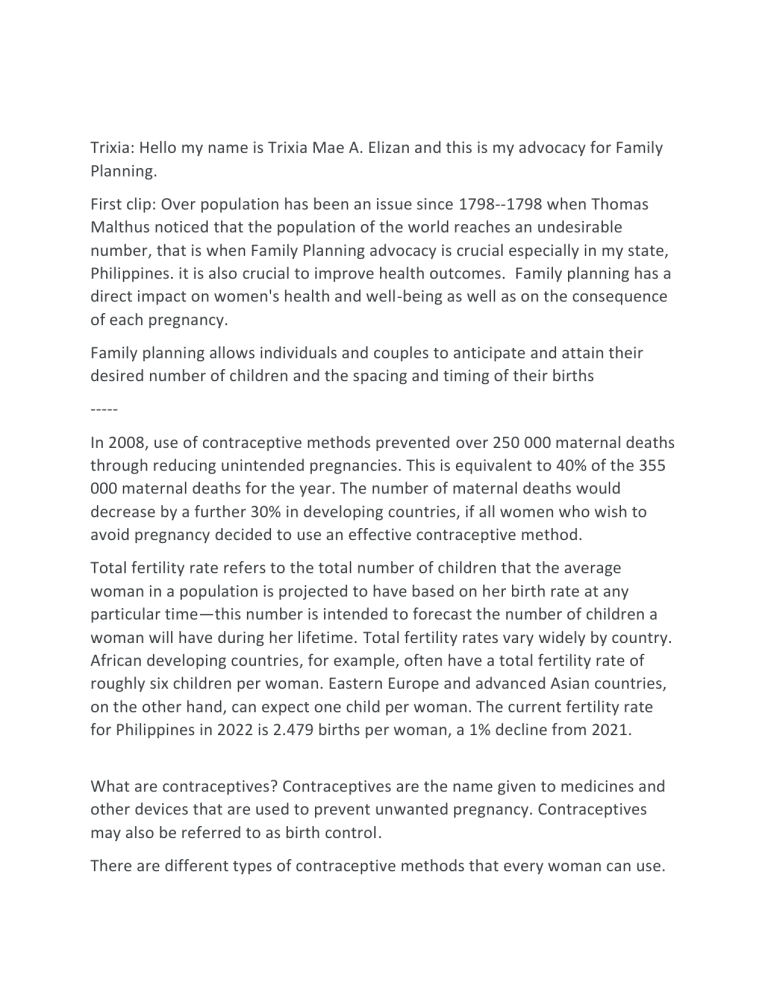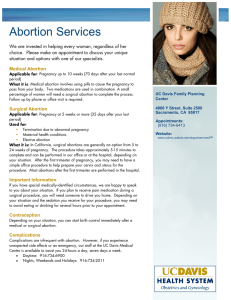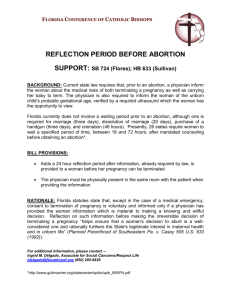
Trixia: Hello my name is Trixia Mae A. Elizan and this is my advocacy for Family Planning. First clip: Over population has been an issue since 1798--1798 when Thomas Malthus noticed that the population of the world reaches an undesirable number, that is when Family Planning advocacy is crucial especially in my state, Philippines. it is also crucial to improve health outcomes. Family planning has a direct impact on women's health and well-being as well as on the consequence of each pregnancy. Family planning allows individuals and couples to anticipate and attain their desired number of children and the spacing and timing of their births ----In 2008, use of contraceptive methods prevented over 250 000 maternal deaths through reducing unintended pregnancies. This is equivalent to 40% of the 355 000 maternal deaths for the year. The number of maternal deaths would decrease by a further 30% in developing countries, if all women who wish to avoid pregnancy decided to use an effective contraceptive method. Total fertility rate refers to the total number of children that the average woman in a population is projected to have based on her birth rate at any particular time—this number is intended to forecast the number of children a woman will have during her lifetime. Total fertility rates vary widely by country. African developing countries, for example, often have a total fertility rate of roughly six children per woman. Eastern Europe and advanced Asian countries, on the other hand, can expect one child per woman. The current fertility rate for Philippines in 2022 is 2.479 births per woman, a 1% decline from 2021. What are contraceptives? Contraceptives are the name given to medicines and other devices that are used to prevent unwanted pregnancy. Contraceptives may also be referred to as birth control. There are different types of contraceptive methods that every woman can use. Such as contraceptive implant, this type of contraceptive is a small flexible plastic rod that is placed under the skin in your upper arm by a doctor or nurse. It releases the hormone progestogen into your bloodstream to prevent pregnancy and lasts for 3 years. Another type of contraceptive is Hormonal contraceptive patch, one patch is applied each week for every three weeks, then usually followed by a patch-free week. Also, Intrauterine devices (IUD) Small, T-shaped device that is inserted through the vagina into the uterus to prevent implantation of a fertilized egg. it also gives you a long-term protection against pregnancy, they are also 99% effective. IUDs can also make a woman’s period better, it can cut down cramps and make your period lighter and it helps treat anemia, IUDs can also Last 3 to 10 years depending on the type. And lastly the use of condom, condom protects someone from having HIV transmission, some studies claim that the condom protects from HIV at an effectiveness rate of 60%, it also protects someone from having gonococci and chlamydia. So moving on There is common reason why women across the world do not practice contraception, it is lack of understanding about methods and reproduction. One of the key causes for women's non-use of contraception has been mentioned as a lack of awareness of modern contraceptive technologies and their mechanisms of action, Lack of awareness of sexual function and the fertile period among women, particularly adolescent girls, may prevent them from ineffectively assessing their risk of pregnancy when they have occasional or infrequent sex. So there are also demands for family planning such as , IUD, male condom, female sterilization and male sterilization. There are also family planning programs and According to DOH, there are family planning programs in Hospitals and other health facilities such as Establishment of FP service package in hospitals Organization of FP Travelling team for outreach missions Delivery of FP services by hospitals to the poor communities especially Geographically Isolated and Disadvantaged Areas (GIDAs): Provision of budget support to operations by the travelling teams including logistics and medical supplies needed for voluntary surgical sterilization services FP services as part of medical and surgical missions of the hospital Partnership with LGU hospitals for the FP outreach missions A number of service delivery systems have emerged. Services can be obtained through specialized family planning clinics or from hospitals. The private sector is frequently involved, either through private physicians or through commercial distribution of subsidized contraceptives. More lately, the tendency has been toward community-based distribution systems that make family planning a natural part of daily village life. Another thing in family planning is abortion, Abortion is a medical procedure that allows a woman to end her pregnancy. This is usually done within the first few months, with the assistance of a doctor. Medical abortions and surgical abortions are the two main types of abortions. The type of abortion used to terminate a pregnancy will be determined by the woman's comfort level, the doctor's recommendation, and the length of time since the woman's last menstrual cycle. Some abortion methods are only safe to use during the first trimester, while others can be used safely in the second or (in extreme cases) third trimester. There are non-surgical abortion which is a medical abortion. A medical abortion does not require surgery or anesthesia, and it can be performed in a medical office or at home, with follow-up visits to your doctor. It is most effective and safe during the first trimester of pregnancy. Risk of medical abortion: Heavy and prolonged bleeding Infection Fever Digestive system discomfort There are also another type of abortion technology which is the Machine Vacuum where this procedure is a common method used in the first 5 to 12 weeks (first trimester) of pregnancy. It involves the use of a thin tube (cannula). The cannula is attached by tubing to a bottle and a pump, which provides a gentle vacuum. The cannula is passed into the uterus, and the pump is turned on. Then the tissue is gently removed from the uterus. Every year, half a million women die as a result of complications related to pregnancy, childbirth, and unsafe abortion. The majority of these deaths could have been avoided with proper family planning. For example, family planning can help to avoid risks associated with pregnancy, such as: too soon. Women under the age of 18 are more likely to die in childbirth because their bodies are not fully grown. Their babies have a greater chance of dying in the first year. too late. Older women face more danger in child bearing, especially if they have other health problems or have had many children. too close. A woman’s body needs time to recover between pregnancies. too many. A woman with more than 4 children has a greater risk of death after childbirth from bleeding and other causes. That is why watching this family planning advocacy is important to all women out there, to educate, to know and to be aware what are the pros and cons of family planning, Good luck ladies!





